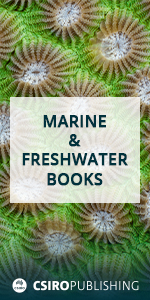Marine and Freshwater Research
Volume 71
Number 4 2020
This study used a sampling strategy designed to examine the relationship between the seasonality of a tropical river and community structure, using data from Amazonian benthic fish assemblages. It was found that species composition varies seasonally, and these differences may suggest a narrow relationship between the benthic ichthyofauna inhabiting the main channel and the marginal wetlands.
Oxygen consumption in the aquatic environment is often assumed to be constant over time in the dark. Here we report non-constant respiration rate on the basis of analysis of a diverse dataset and describe how the patterns in respiration rate vary with the community structure and the trophic status of the ecosystems. These findings will help us better understand carbon cycling in the aquatic ecosystem.
In this study we assessed how often flatback turtles returned to nest and the environmental cues they use to time their nesting attempts. Turtles nested every 13 days within a season and returned to nest every 2 years on average within ~450 m of their previous nesting location. Turtles preferred to nest on the least exposed side of the island and when air temperature and humidity were lowest and tides were highest.
To gather information on oceanic life histories and possible differences in spawning times and locations of freshwater eels in the western South Pacific, otoliths of three species occurring in Fiji were studied. Significant differences between the life histories of all three species were observed. Furthermore, separate peak seasonal spawning periods for each of the three species was revealed.
Studies on keystone species will contribute to the understanding of community stability and mechanisms underlying ecosystem degradation. Leptochela gracilis, Loligo sp., Larimichthys polyactis, Alpheus japonicus and Oratosquilla oratoria were identified as keystone species in the Haizhou Bay food web, and their absence may have considerable effects on the complexity and stability of the Haizhou Bay food web. This study provides a scientific basis for the protection of maintenance of ecosystem health in Haizhou Bay.
Human activities alter the growth of coastal wetland vegetation. In the present study, we showed that the use of canopy hyperspectral data can reveal the biomass of Suaeda salsa under the influence of different types of human activity. This study provides technical support for the use of quantitative remote sensing-based methods to monitor the fragile ecology of coastal wetlands under the influence of human activities.
Food availability, competition, predation and salinity affect the survival and growth of aquatic invertebrates, such as rotifers. Brachionus plicatilis (saline) and Brachionus calyciflorus (freshwater) coexist in Salado River basin waterbodies (Argentina) depending on particular conditions. The findings of this study indicate that B. calyciflorus is more adversely affected than B. plicatilis by competition and high salinity, which explains how both species can coexist.
Large Cladocera species are considered as keystone species in many freshwater ecosystems. Fish predation usually reduces their populations, with a cascading effect on phytoplankton biomass. A mesocosm experiment suggested that an intentional elimination of Daphnia females with more visible advanced embryos can strengthen the top-down effect of fish predation on reproduction success of daphnids and, therefore, decelerate their population growth.
Managing a fish population often requires understanding its diet, which involves many hours spent using a microscope to examine the contents of the fish guts. We used a DNA-technique that rapidly identified the prey of two species of blackfish that can cohabit zones of rivers. We showed that some prey were consumed by both species, but other prey were only present in one of the species. Different diets can allow two species to coexist.
We investigated the number and distribution of trevally species in the Pseudocaranx dentex complex in Australian waters. We found one species (P. sp. ‘dentex’) that shows close affinities with trevallies from southern Africa and the Mediterranean Sea, another (P. georgianus) that is widespread in southern Australia and a third (P. dinjerra) from deep water in Western Australia. These results will facilitate the management of harvested stocks of this complex.
We analysed a historic database of blue marlin catch. We used a numerical model to evaluate the effects of marine climate indexes in the variations of blue marlin catch. These variations are more affected by operational changes in the longline fishery than by variations in marine climate. Blue marlin catch showed an important decrease from the early 2000s, and the causes of this decline should be investigated.
Catch data from commercial fisheries can provide an indicator of stock status. Naïve, univariate and multivariate time series models of monthly catch per unit effort were developed for King George whiting, snapper and southern calamari. Predictive models that included seasonality or environmental variables performed the best, particularly for species that are vulnerable to fishing during short phases in their life history or for which intra-annual variation in abundance occurs through environmental variability.
Alimentary exposure is the main factor determining halogenated organic compound pollution of wildlife. Comparisons of two aquatic environments, namely marine coast (Gdansk Bay) and an inland reservoir (Włocławek Dam on the Vistula River), indicated significant differences in contamination of birds’ eggs. Concentrations of polychlorinated dibenzo-p-dioxins and furans as well as polychlorinated biphenyls were similar but TEQ were several times higher in fish eating birds. The same was observed for hexabromocyclododecane isomers





